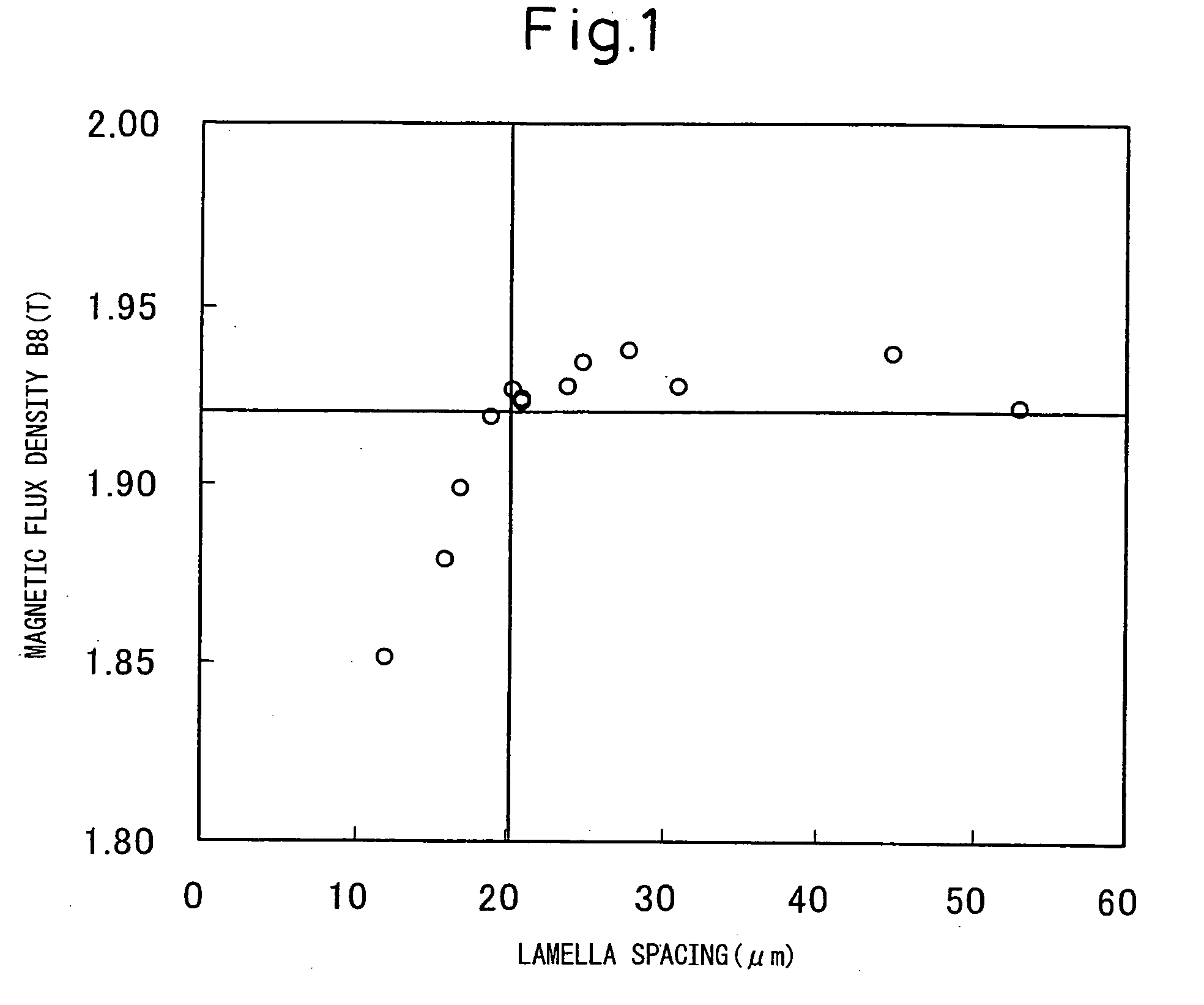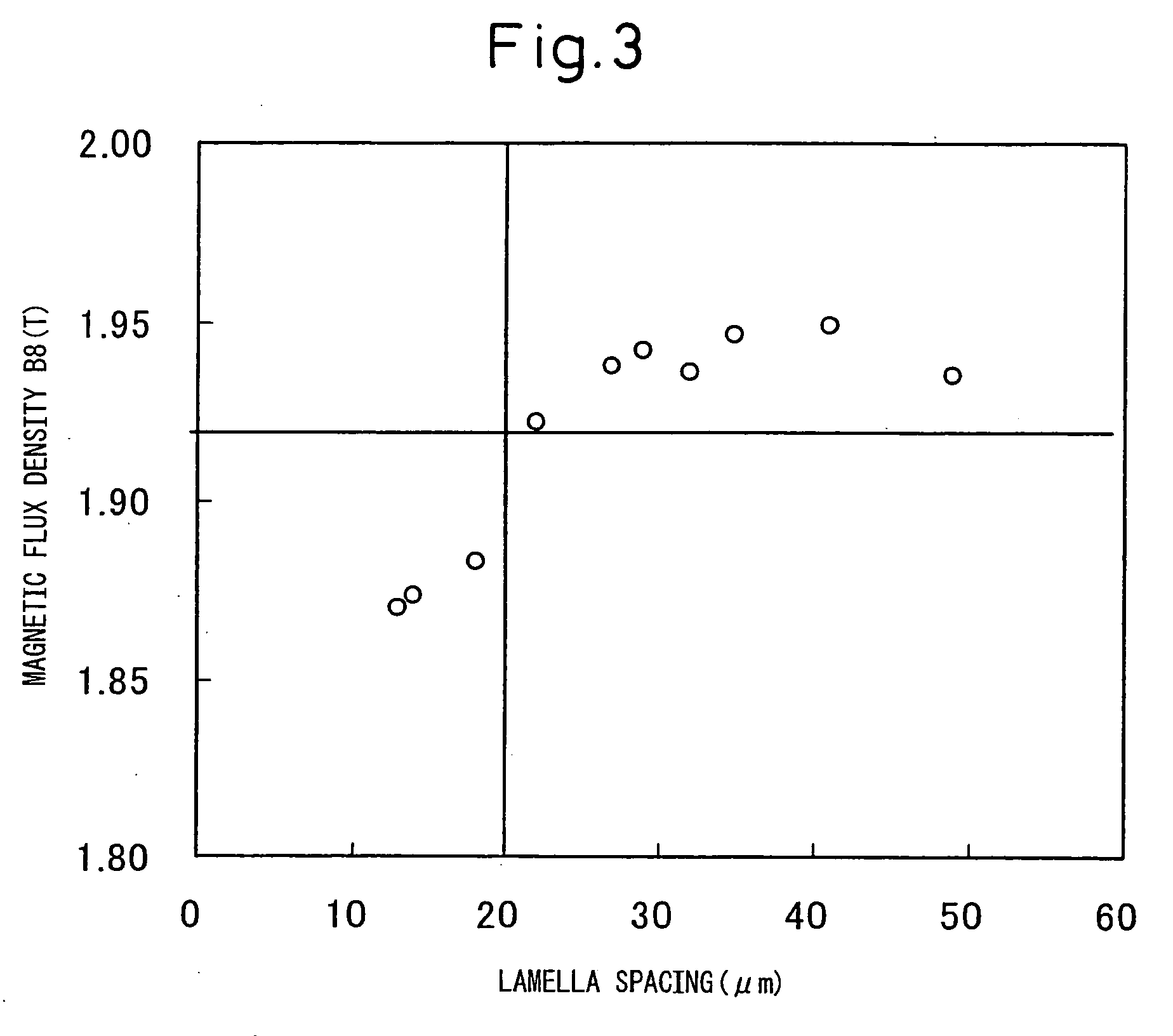Method of production of grain-oriented electrical steel sheet having a high magnetic flux density
a technology of magnetic flux density and grain-oriented electrical steel, which is applied in the direction of magnetic bodies, furnaces, heat treatment apparatuses, etc., can solve the problems of damage to the sheet, difficult induction heating, and large amount of molten scal
- Summary
- Abstract
- Description
- Claims
- Application Information
AI Technical Summary
Benefits of technology
Problems solved by technology
Method used
Image
Examples
example 1
[0114]Slabs containing, in mass %, Si: 3.2%, C, 0.05%, acid-soluble Al: 0.024%, N: 0.005%, Mn: 0.04%, S: 0.01% and the balance of Fe and unavoidable impurities were heated to 1320° C. (in the case of this composition system, T1=1242° C., T2=1181° C.) and hot-rolled to a thickness of 2.3 mm. Then, one-stage annealing was conducted on some specimens (A) at 1130° C., and two-stage annealing was conducted on some specimens (B) at 1130° C.+920° C. The specimens were cold-rolled to a thickness of 0.3 mm, and were then heated to 720° C. at a heating rate of (1) 15° C. / s, (2) 40° C. / s, and (3) 100° C. / s, then heated to 850° C. at 10° C. / s, decarburization-annealed and annealed in an ammonia-containing gaseous atmosphere, increasing the nitrogen in the steel sheet to 0.02%. The specimens were then coated with an annealing separator having MgO as its main component, and finish-annealed.
[0115]Table 1 shows the magnetic properties of the specimens after finish-annealing. The specimen symbols de...
example 2
[0116]Slabs containing, in mass %, Si: 3.2%, C: 0.055%, acid-soluble Al: 0.026%, N: 0.005%, Mn: 0.04%, S: 0.015% and the balance of Fe and unavoidable impurities were heated to 1330° C. (in the case of this composition system, T1=1250° C., T2=1206° C., T4=1212° C.) and hot-rolled to a thickness of 2.3 mm. Then, one-stage annealing was conducted on some specimens (A) at 1120° C., and two-stage annealing was conducted on some specimens (B) at 1120° C.+900° C. The specimens were cold-rolled to a thickness of 0.3 mm, and were then heated to 550° C. at a heating rate of 20° C. / s, then further heated from 550° C. to 720° C. at (1) 15° C. / s, (2) 40° C. / s, and (3) 100° C. / s, then further heated to 840° C. at 15° C. / s and decarburization-annealed at that temperature and annealed in an ammonia-containing gaseous atmosphere, increasing the nitrogen in the steel sheet to 0.02%. The specimens were then coated with an annealing separator having MgO as its main component, and finish-annealed.
[0117...
example 3
[0118]Following hot rolling, specimens fabricated in Example 2 were subjected to two-stage annealing at 1120° C.+900° C. to produce a lamella spacing of 24 μm. The specimens were cold-rolled to a thickness of 0.3 mm, and were then heated to 550° C. at a heating rate of 20° C. / s, further heated from 550° C. to 720° C. at 40° C. / s, and then further heated to 840° C. at 15° C. / s and decarburization-annealed at that temperature, which was followed by annealing in an ammonia-containing gaseous atmosphere, increasing the nitrogen in the steel sheet 0.008 to 0.020%. The specimens were then coated with an annealing separator having MgO as its main component, and finish-annealed.
[0119]Table 3 shows the magnetic properties, after finish-annealing, of the specimens having different nitrogen amounts.
TABLE 3NitrogenMagnetic fluxamountdensity B8Specimen(%)[N] / [Al](T)Remarks(A)0.0080.311.623Comparativeexample(B)0.0110.421.790Comparativeexample(C)0.0170.651.929Inventionexample(D)0.0200.771.933Inven...
PUM
| Property | Measurement | Unit |
|---|---|---|
| Temperature | aaaaa | aaaaa |
| Temperature | aaaaa | aaaaa |
| Temperature | aaaaa | aaaaa |
Abstract
Description
Claims
Application Information
 Login to View More
Login to View More - R&D
- Intellectual Property
- Life Sciences
- Materials
- Tech Scout
- Unparalleled Data Quality
- Higher Quality Content
- 60% Fewer Hallucinations
Browse by: Latest US Patents, China's latest patents, Technical Efficacy Thesaurus, Application Domain, Technology Topic, Popular Technical Reports.
© 2025 PatSnap. All rights reserved.Legal|Privacy policy|Modern Slavery Act Transparency Statement|Sitemap|About US| Contact US: help@patsnap.com



